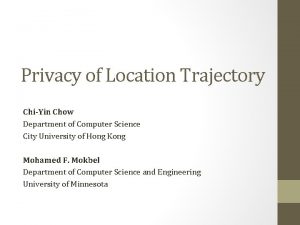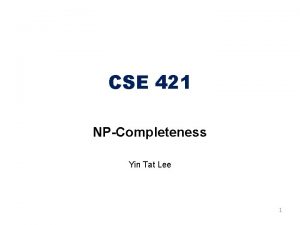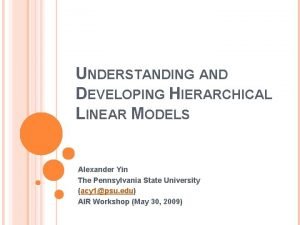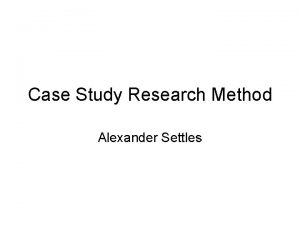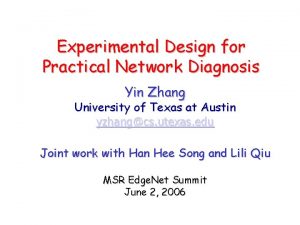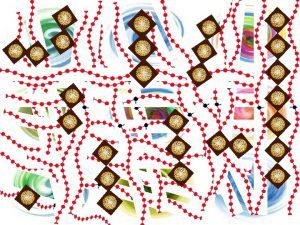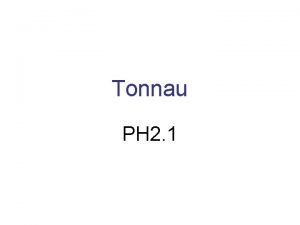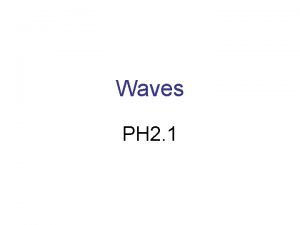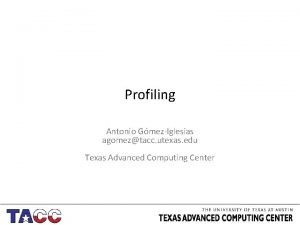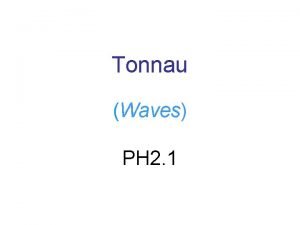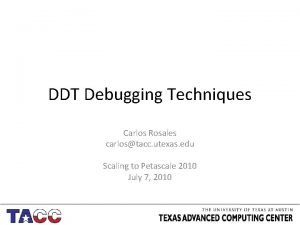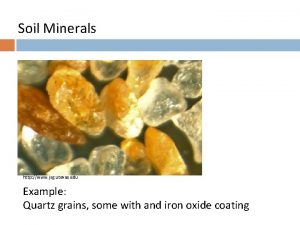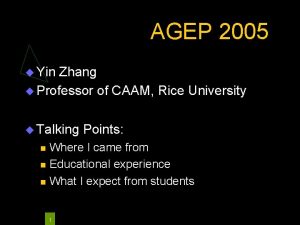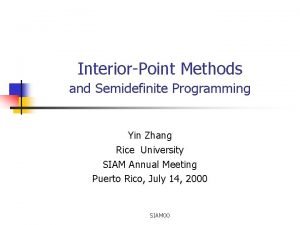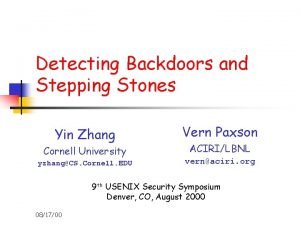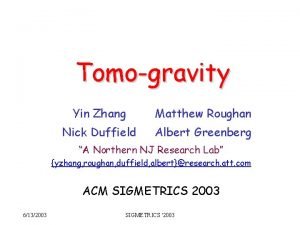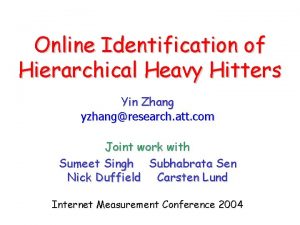Network Anomography Yin Zhang yzhangcs utexas edu Joint


![3 Network Anomography • What we want B C – Volume anomalies [Lakhina 04] 3 Network Anomography • What we want B C – Volume anomalies [Lakhina 04]](https://slidetodoc.com/presentation_image_h/06c0cfd08c0bf17921cdc3855912ed7d/image-3.jpg)
![An Illustration Courtesy: Anukool Lakhina [Lakhina 04] 4 An Illustration Courtesy: Anukool Lakhina [Lakhina 04] 4](https://slidetodoc.com/presentation_image_h/06c0cfd08c0bf17921cdc3855912ed7d/image-4.jpg)




















- Slides: 24

Network Anomography Yin Zhang yzhang@cs. utexas. edu Joint work with Zihui Ge, Albert Greenberg, Matthew Roughan Internet Measurement Conference 2005 Berkeley, CA, USA

Network Anomaly Detection • Is the network experiencing unusual conditions? – Call these conditions anomalies – Anomalies can often indicate network problems • DDo. S, worms, flash crowds, outages, misconfigurations … – Need rapid detection and diagnosis • Want to fix the problem quickly • Questions of interest – Detection • Is there an unusual event? – Identification • What’s the best explanation? – Quantification • How serious is the problem? 2
![3 Network Anomography What we want B C Volume anomalies Lakhina 04 3 Network Anomography • What we want B C – Volume anomalies [Lakhina 04]](https://slidetodoc.com/presentation_image_h/06c0cfd08c0bf17921cdc3855912ed7d/image-3.jpg)
3 Network Anomography • What we want B C – Volume anomalies [Lakhina 04] Significant changes in an Origin-Destination flow, i. e. , traffic matrix element • What we have – Link traffic measurements – It is difficult to measure traffic matrix directly A • Network Anomography – Infer volume anomalies from link traffic measurements
![An Illustration Courtesy Anukool Lakhina Lakhina 04 4 An Illustration Courtesy: Anukool Lakhina [Lakhina 04] 4](https://slidetodoc.com/presentation_image_h/06c0cfd08c0bf17921cdc3855912ed7d/image-4.jpg)
An Illustration Courtesy: Anukool Lakhina [Lakhina 04] 4

5 Anomography = Anomalies + Tomography

Mathematical Formulation Only measure at links 1 route 3 link 1 route 2 router link 2 2 route 1 3 link 3 Problem: Infer changes in TM elements (xt) given link measurements (bt) 6

Mathematical Formulation Only measure at links 1 route 3 link 1 route 2 router link 2 2 route 1 3 link 3 b t = A t xt (t=1, …, T) Typically massively under-constrained! 7

Static Network Anomography Only measure at links 1 route 3 link 1 route 2 router link 2 2 route 1 3 link 3 B = AX Time-invariant At (= A), B=[b 1…b. T], X=[x 1…x. T] 8

Anomography Strategies • Early Inverse 1. Inversion – Infer OD flows X by solving bt=Axt – Extract volume anomalies X from inferred X 2. Anomaly extraction Drawback: errors in step 1 may contaminate step 2 • Late Inverse 1. Anomaly extraction – Extract link traffic anomalies B from B – Infer volume anomalies X by solving bt=Ax t 2. Inversion Idea: defer “lossy” inference to the last step 9

Extracting Link Anomalies B • Temporal Anomography: B = BT – ARIMA modeling • Diff: • EWMA: ft = bt-1 ft = (1 - ) ft-1 + bt-1 – Fourier / wavelet analysis bt = bt – f t • Link anomalies = the high frequency components – Temporal PCA • PCA = Principal Component Analysis • Project columns onto principal link column vectors • Spatial Anomography: B = TB – Spatial PCA [Lakhina 04] • Project rows onto principal link row vectors 10

Extracting Link Anomalies B • Temporal Anomography: B = BT – Self-consistent • Tomography equation: • Post-multiply by T: B = AX BT = AXT B = AX • Spatial Anomography: B = TB – No longer self-consistent 11

Solving bt = A xt 12 • Pseudoinverse: xt = pinv(A) bt – Shortest minimal L 2 -norm solution • Minimize |xt|2 subject to |bt – A xt|2 is minimal • Maximize sparsity (i. e. minimize |xt|0) – L 0 -norm is not convex hard to minimize – Greedy heuristic • Greedily add non-zero elements to x t • Minimize |bt – A x t|2 with given |x t|0 – L 1 -norm approximation • Minimize |x t|1 (can be solved via LP) • With noise minimize |xt|1 + |bt-Ax t|1

Dynamic Network Anomography 13 • Time-varying At is common – Routing changes – Missing data • Missing traffic measurement on a link setting the corresponding row of At to 0 in bt=Atxt • Solution – Early inverse: Directly applicable – Late inverse: Apply ARIMA modeling • L 1 -norm minimization subject to link constraints – minimize subject to |xt|1 x t = xt – xt-1, bt=Atxt, bt-1=At-1 xt-1 • Reduce problem size by eliminating redundancy

Performance Evaluation: Inversion 14 • Fix one anomaly extraction method • Compare “real” and “inferred” anomalies – “real” anomalies: directly from OD flow data – “inferred” anomalies: from link data • Order them by size – Compare the size • How many of the top N do we find – Gives detection rate: | top N”real” top Ninferred | / N

Inference Accuracy Tier-1 ISP (10/6/04 – 10/12/04) Diff (bt = bt – bt-1) Sparsity-L 1 works best among all inference techniques 15

Inference Accuracy Tier-1 ISP (10/6/04 – 10/12/04) Diff (bt = bt – bt-1) detection rate = | top Nreal top Ninferred | / N Sparsity-L 1 works best among all inference techniques 16

Impact of Routing Changes Tier-1 ISP (10/6/04 – 10/12/04) Diff (bt = bt – bt-1) Late inverse (sparsity-L 1) beats early inverse (tomogravity) 17

Performance Evaluation: Anomography 18 • Hard to compare performance – Lack ground-truth: what is an anomaly? • So compare events from different methods – Compute top M “benchmark” anomalies • Apply an anomaly extraction method directly on OD flow data – Compute top N “inferred” anomalies • Apply another anomography method on link data – Report min(M, N) - | top Mbenchmark top Ninferred | • M < N “false negatives” # big “benchmark” anomalies not considered big by anomography • M > N “false positives” # big “inferred” anomalies not considered big by benchmark method – Choose M, N similar to numbers of anomalies a provider is willing to investigate, e. g. 30 -50 per week

19 Anomography: “False Negatives” Top 50 Inferred “False Negatives” with Top 30 Benchmark Diff EWMA H-W ARIMA Fourier Wavelet T-PCA S-PCA Diff 0 0 1 1 5 5 17 12 EWMA 0 0 1 1 5 5 17 12 Holt-Winters 1 1 0 0 6 4 18 12 ARIMA 1 1 0 0 6 4 18 12 Fourier 3 4 8 8 1 7 19 18 Wavelet 0 1 2 2 5 0 13 11 T-PCA 14 14 19 15 3 15 S-PCA 10 10 13 13 15 11 1 13 1. Diff/EWMA/H. -W. /ARIMA/Fourier/Wavelet all largely consistent 2. PCA methods not consistent (even with each other) - PCA cannot detect anomalies in the “normal” subspace - PCA insensitive to reordering of [b 1…b. T] cannot utilize all temporal info 3. Spatial methods (e. g. spatial PCA) are not self-consistent

20 Anomography: “False Positives” Top 30 Inferred “False Positives” with Top 50 Benchmark Diff EWMA H-W ARIMA Fourier Wavelet T-PCA S-PCA Diff 3 3 6 6 6 4 14 14 EWMA 3 3 6 6 7 5 13 15 Holt-Winters 4 4 1 1 8 3 13 10 ARIMA 4 4 1 1 8 3 13 10 Fourier 6 6 7 6 2 6 19 18 Wavelet 6 6 8 1 13 12 T-PCA 17 17 20 13 0 14 S-PCA 18 18 20 14 1. Diff/EWMA/H. -W. /ARIMA/Fourier/Wavelet all largely consistent 2. PCA methods not consistent (even with each other) - PCA cannot detect anomalies in the “normal” subspace - PCA insensitive to reordering of [b 1…b. T] cannot utilize all temporal info 3. Spatial methods (e. g. spatial PCA) are not self-consistent

Summary of Results 21 • Inversion methods – Sparsity-L 1 beats Pseudoinverse and Sparsity-Greedy – Late-inverse beats early-inverse • Anomography methods – Diff/EWMA/H-W/ARIMA/Fourier/Wavelet all largely consistent – PCA methods not consistent (even with each other) • PCA methods cannot detect anomalies in “normal” subspace • PCA methods cannot fully exploit temporal information in {xt} – Reordering of [b 1…b. T] doesn’t change results! – Spatial methods (e. g. spatial PCA) are not self-consistent • Temporal methods are • The method of choice: ARIMA + Sparsity-L 1 • • Accurate, consistent with Fourier/Wavelet Robust against measurement noise, insensitive to choice of Works well in the presence of missing data, routing changes Supports both online and offline analysis

Conclusions • • – Anomography = Anomalies + Tomography Find anomalies in {xt} given bt=Atxt (t=1, …, T) Contributions 1. A general framework for anomography methods – Decouple anomaly extraction and inference components – – Taking advantage of the range of choices for anomaly extraction and inference components Choosing between spatial vs. temporal approaches – 6 -month Abilene and 1 -month Tier-1 ISP 2. A number of novel algorithms 3. The first algorithm for dynamic anomography 4. Extensive evaluation on real traffic data • The method of choice: ARIMA + Sparsity-L 1 22

Future Work • Correlate traffic with other types of data – BGP routing events – Router CPU utilization • Anomaly response – Maybe with an effective response system, false positives become less important? • Anomography for performance diagnosis – Inference of link performance based on end-to-end measurements can be formulated as bt=Axt • Beyond networking – Detecting anomalies in other inverse problems – Are we just reinventing the wheel? 23

24 Thank you !
 Pbis points hack
Pbis points hack Ece utexas
Ece utexas Laits ut austin
Laits ut austin Quality grade of lamb
Quality grade of lamb Hyaline cartilage in vertebrae
Hyaline cartilage in vertebrae Permanent and temporary welding
Permanent and temporary welding Memorandum joint venture
Memorandum joint venture Lamb carcass grading
Lamb carcass grading Plane joint
Plane joint Edu.sharif.edu
Edu.sharif.edu Yin yang marketing
Yin yang marketing Chi-yin chow
Chi-yin chow Yin characteristics
Yin characteristics Mehmon-mehmon o'yini
Mehmon-mehmon o'yini Savodga o'rgatish mashg'ulot ishlanmasi
Savodga o'rgatish mashg'ulot ishlanmasi Meridianos yin
Meridianos yin Os cinco elementos
Os cinco elementos Yin energy characteristics
Yin energy characteristics Yin tat lee
Yin tat lee Yin yang fish dish
Yin yang fish dish Alexander yin
Alexander yin Mike yin new zealand
Mike yin new zealand Wenyan yin
Wenyan yin Building theories from case study research
Building theories from case study research How to conclude a case study
How to conclude a case study











